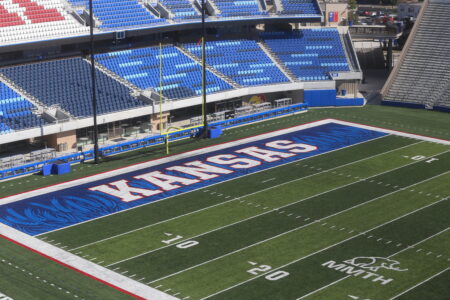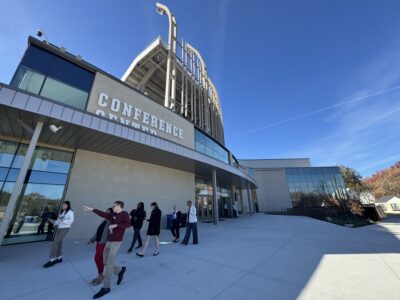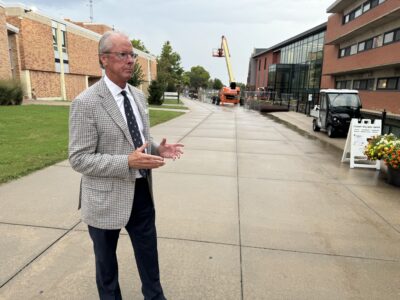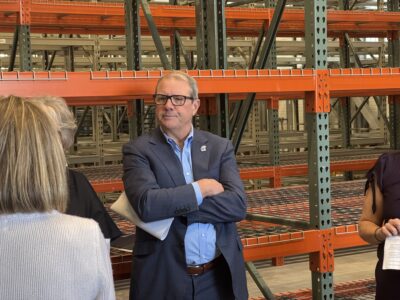Kansas Legislature fails to provide key approval for $60M School of Architecture expansion; a look at status of other KU building projects

photo by: University of Kansas
This rendering shows a proposed six-story building that would be constructed on the University of Kansas campus to service the KU school of architecture and design. The building would be built behind Marvin Hall, which is on the west end of Jayhawk Boulevard.
A roiled bond market hasn’t yet threatened plans for a $300-million-plus hotel, retail and student housing development around the University of Kansas’ football stadium.
A quiet Kansas Legislature, however, has thrown into question the future of another KU project: A $60 million building expansion for KU’s School of Architecture & Design.
As part of its budget deliberations, the Kansas Legislature declined to provide $60 million in bonding authority for the project, which now means KU doesn’t have a clear path for financing the project that would add lots of design studios and technology spaces for the school.
KU leaders also don’t have a clear answer on why the project didn’t win the Legislature’s support. Jeff DeWitt, KU’s chief financial officer, said he testified before legislative committees on a multitude of bond issues for KU.
“That’s the one project they didn’t ask me any questions about,” DeWitt told the Journal-World in a brief interview. “I don’t know why they didn’t approve it.”
DeWitt said KU plans to seek the bonding authority again during next year’s legislative session. That may mean the architecture expansion will be delayed by at least a year, but DeWitt stopped short of saying that would be the case.
“We are trying to figure out how to keep it moving,” he said.
The architecture expansion may not have been the project most outsiders were worried about being stalled. As the U.S. bond market has been in tumult as a result of the current trade war, there’s been speculation that rising interest rates for debt may ruin the feasibility of the second phase of KU’s Gateway project, which aims to convert the area around David Booth Kansas Memorial Stadium into a commercial and tourism hub.
As reported, KU plans to partner with a private entity to build an upscale Marriott hotel, a mix of restaurants and retailers, more than 400 new student apartments, and a unique 20,000-square-foot plaza area for outdoor entertainment, all of which would complement the convention center that is being constructed as part of the football stadium renovation that is nearing completion.
KU in December selected a private development group headed by Edgemoor Infrastructure & Real Estate to serve as the private developer of the project. It will be responsible for many of the costs related to the hotel, retail, restaurants and other amenities, while KU will be responsible for east side improvements to the stadium and other such costs.
The financial markets — and the outlook for long-term interest rates — were far different in December than they are now. But, thus far the development group isn’t blinking at the prospect of rising interest rates and the added cost that would create for the project.
“I meet with them three times a week,” DeWitt said of the private development group. “The developers are still optimistic that they can navigate the waters.”
In Edgemoor, KU is working with a large developer with significant resources. The company was the lead developer of the new Kansas City International Airport.
A bigger question at this point is whether the Gateway project will win a key vote from the Lawrence City Commission. KU is proposing to pay for the parts of the project not funded by the private developers with the use of a special type of financing called STAR bonds. Those bonds are special because they capture all the sales tax revenue of a district — both local and state sales taxes — and use that money to pay for infrastructure and other such development costs.
However, the bonds need a myriad of government approvals. For STAR bonds to be used, the Lawrence City Commission must approve KU’s STAR bond proposal — which calls for all of the Lawrence campus, not just the area around the stadium, to be a part of the sales tax district.
City commissioners have scheduled a public hearing for May 6 to consider the STAR bond proposal. KU officials say that will be a make-or-break vote for the project.
“If the commission doesn’t approve it, it can’t go forward,” DeWitt said.
KU has argued the Gateway will produce major benefits for the Lawrence economy. The hotel, KU leaders said, is critical to having the 1,000-seat conference center operate at full capacity. The center, and the stadium itself, also is expected to host a multitude of entertainment events that will bring visitors to town, and KU is betting that the Gateway district will elevate the overall look and energy level of the campus, which will help in attracting students, KU leaders have said.

photo by: Chad Lawhorn/Journal-World
Kansas Board of Regents Chair Carl Ice, center, is pictured at the Regents’ April 16 meeting at Pittsburg State University.
KU officials were talking about various building plans and debt at the Kansas Board of Regents on Wednesday. KU was required to submit its five-year capital improvement plan for Regents for preliminary approval.
The capital improvement plan, in theory, is a list of projects that the university intends to build in the next five years. In practice, however, the plan is better described as a list of projects that KU is working to raise funds to build. State policies require a project to be on the capital improvement plan before a university can try to raise funds for it.
The development of the area around the football stadium — which KU is calling phase II of its Gateway Project — is the biggest project on the list going forward. The plan calls for $172 million of construction on the project in fiscal year 2026, which begins this July. The plan calls for another $98 million in fiscal year 2027 and $50 million in fiscal year 2028.
DeWitt said, assuming that the STAR bonds win all of their necessary approvals, the phase II projects could be under construction after the end of the KU home football season in the fall. The phase II project ultimately will require the removal and replacement the east grandstands of the football stadium, but DeWitt said there are no plans for that removal to happen before the upcoming football season. Chancellor Douglas Girod also has said that when that time comes, there are no plans for KU to move the football games to Kansas City or elsewhere, which was the path KU took last season while the west side of the stadium was under construction.
Here’s a look at several other projects that were included on KU’s five-year CIP:
• $50 million for a new wellness center to replace the aged Watkins Student Health Center. Documents presented to Regents said current plans call for the current Watkins building to be razed once a new building is constructed. The documents don’t specify where the new center would be located. The project doesn’t yet have all of the funding needed to begin, but fundraising is underway. The plan lists that $25 million of construction possibly could occur in fiscal year 2026.
• $30.5 million to renovate Anschutz Library into a new student academic success center. Documents provided to Regents said the success center would house departments such as academic advising, student affairs, the Kansas Algebra Program, a career center and other such functions. Fundraising is underway, but the project doesn’t have enough funding yet to begin. The plan lists that $20 million of construction could possibly occur in fiscal year 2026.
• $75 million for a new dormitory project. KU officials have said they need about 1,000 additional student beds to meet current and projected enrollment, which recently hit a new high. Phase II of the Gateway project envisions a 400-bed student housing facility to be built near the stadium as part of the public-private partnership. But DeWitt said KU is actively exploring how it could meet the remaining 600-bed demand. That could involve buying an existing private facility. KU currently is leasing all the space at Naismith Hall, a privately owned dormitory south of campus. But the project also could involve building a new dormitory from scratch. No location has been identified, but leaders have discussed building a replacement for Oliver Hall, which was located at 19th and Naismith, and also have noted that space will be available at the site of Jayhawker Towers, as plans call for razing of at least one of those aged towers in the near future. The Kansas Legislature did approve $100 million bonding authority for the university to use for student housing needs, which means this project may be more likely than some others to develop in 2026.
• $15 million to renovate the Robinson Center — KU’s former recreation center — into a new home for the various ROTC military programs that are located on the Lawrence campus. The project has some state money available to it through the state’s education building fund, but also is seeking private funds to allow the project to begin. The plan lists that $13.75 million of construction possibly could occur in fiscal year 2026.
Several other potential building projects that have been reported on over the years remain on KU’s capital improvement plan, but show up only in distant years, which indicates the university doesn’t believe they will quickly advance. Those projects include a $100 million renovation of Watson Library, $251.8 million for a new integrated science building near Gray-Little Hall in KU’s Central District, and $50 million to renovate and expand Lippincott Hall to serve as the home for the KU law school.







